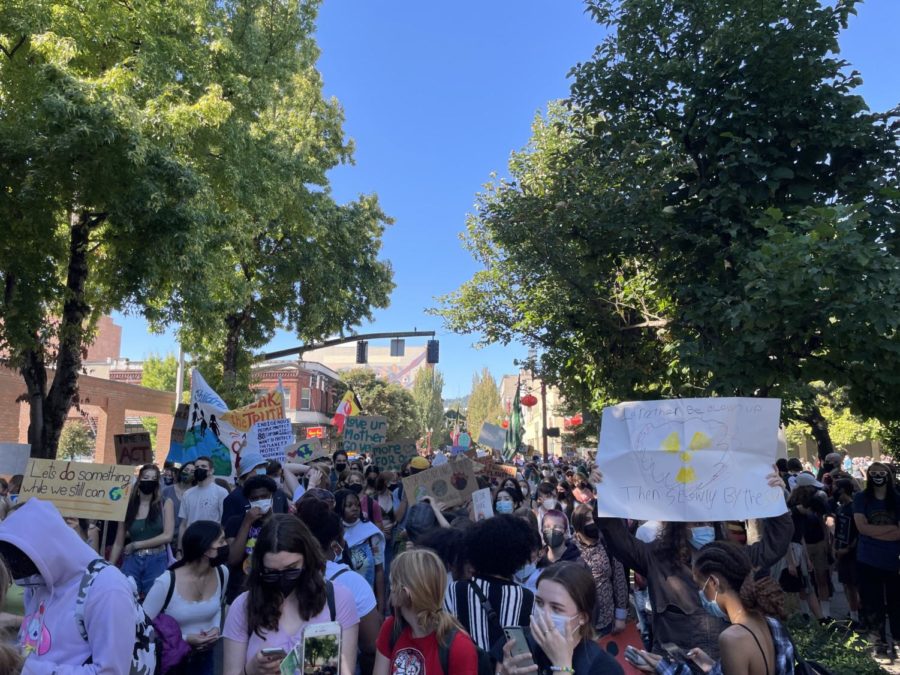The Widespread Influence of the Global Climate Strike Sept. 24
Clarion photo Simone Maher
Youth participating in the Sept. 24 Global Climate Strike in Portland, Oregon.
The COVID-19 pandemic put many aspects of life on hold, and protests were not spared. Although advocates worked hard to adapt protests to online formats, it was hard to reach anything of magnitude by way of climate change protest. With vaccines rolling out over the past year, however, activists have once again returned to the streets to protest against climate change.
On Sept. 24, 2021, youth and fellow advocates in more than 99 countries around the world took to the streets in protest against climate change. Protestors urged different legislation, depending on each city’s most dire needs. Here in Portland, Oregon, hundreds of students marched from the Oregon Convention Center to the city hall to pressure legislators into moving towards a carbon neutral city by 2035, rather than the city’s original goal of 2040.
Fridays for Future, the organization founded by the world renowned Greta Thunberg, propelled the Sept. 24 global strike. As stated on their page, “The climate crisis does not exist in a vacuum. Other socio-economic crises such as racism, sexism, ableism, class inequality, and more amplify the climate crisis and vice versa.” This acknowledgement of intersectionality resonates with many across the world who are drawing attention to marginalization amplified by climate issues (and vice versa, as Fridays for Future emphasizes). For example, the land back movement and anti-colonialism is tied closely with the climate justice movement.
A member of the Portland Youth Climate Strike (PCYS) explained to The Portland State Vanguard “…during the downtime of the pandemic, there has been growth in conversation and reflection, including how to center voices without tokenizing, such as providing stipends for speakers when possible as youth typically go unpaid for their labor, and honoring Indigenous, First Nations and Native communities who have been fighting for the earth for centuries.” It is imperative that intersectional activism is included in climate activism and marginalized voices are uplifted so that we are not leaving behind voices and causes that have been suppressed for years.
Beyond the global climate strikes, Fridays for Future advocates for climate justice through educating the public and government officials and campaigning for policies. In addition, they train young people to expand the movement to their own communities by initiating weekly Friday strikes.
Fridays for Future centered the strike and other actions around six messages to world leaders and four messages to the public to amplify climate justice. Participants are asking the Global North to enact policies that significantly limit emissions. They call on the colonizers that owe climate debt and state that leaders must end the “violence and criminalization against indigenous peoples, small farmers, small fisherfolk, and other environmental land defenders.” Fridays for Future demands that world leaders recognize the danger of the crisis to humanity and the importance of biodiversity on indigenous communities. They ask that leaders declare ecocide an international crime and affirm the rights of climate refugees.
The organization asks the public to recognize that MAPA (Most Affected Peoples and Areas) are not silent because of choice or capability, but rather silenced by systemic oppression. They are not poor, but “rich in resources that have been historically and systematically oppressed and kept from developing.” They urge the public to amplify the voices of MAPA because proposed climate legislation does not include marginalized communities, and further action will continue to be needed. Lastly, Fridays for Futures calls for unity–for individuals to congregate to fight for our future. The narrative of the strike drives the public and calls world leaders to make lasting and impactful changes.
Hundreds of thousands of individuals came together on Sept. 24 to draw attention to the imminence of global disaster. This was not the first protest of this sort, and will not be the last. We must continue to take action and follow the lead of organizers who urge politicians to make the strides that will improve the status quo.






